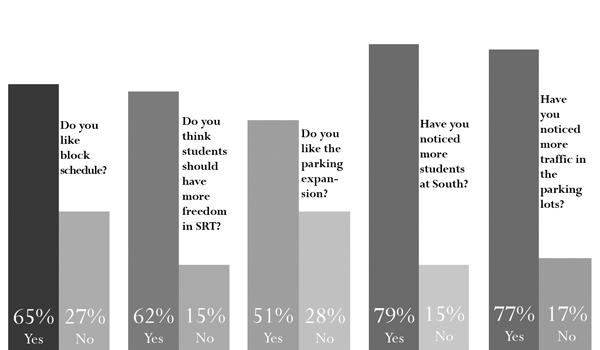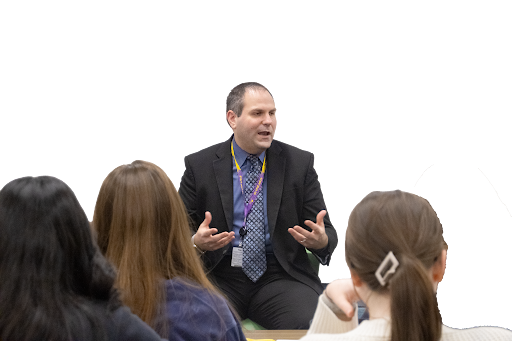Various changes have been made to South this year, including block scheduling, a Student Resource Time (SRT) for most students and added para-pros in the hallways.
The block schedule, according to sophomore Anna Patent, makes school more engaging because students have alternating classes each day.
“Last year, you had eight classes, and you were kind of used to a structured schedule, which kind of got boring and a little bit tedious,” Patent said.
Patent also enjoys using the extra day between classes to complete homework.
“You have extra time to figure out what you’re doing,” Patent said.
Like Patent, junior Rebecca Wittenstein believes the block schedule makes homework more manageable.
“I [have work for] four hours on Tuesdays and Thursdays, so I know I can get my homework done earlier or later,” Wittenstein said. “I don’t have to get it done that night because I don’t have those classes the next day.”
Opposite to Patent and Wittenstein, sophomore Kalina Barneva preferred homework on the period schedule.
“My [homework schedule] is a lot more confusing, because last year’s period schedule [made it] easy to know that you have to do homework for every class, each day,” Barneva said.
On the contrary, Wittenstein believes having an SRT helps to make homework more manageable because it allows extra time during the day to be productive.
“It’s a nice downtime, especially because I have earlybird,” Wittenstein said. “[My] SRT gives me a chance to relax and get homework done.”
Senior Keelan Meehan dislikes SRT because it replaced free periods and limits some of the ways juniors and seniors were able to use their free periods in the past. One of the ways he believes his freedom was limited was through the removal of the ability to use free periods as late arrival or early release.
“I don’t like how instead of having a free period we are restrained to come to school,” Meehan said. “I don’t understand why we had that freedom [junior year] and now we suddenly do not.”
However, according to Dr. Lara Cummings, assistant principal in charge of student services, this ability remains for juniors and seniors.
“[Students with] SRT first block could fill out a form and do a late arrival or something like that,” Cummings said. “[A student] could be gone for half the block and we’d still meet our […] required number of minutes.”
According to Meehan, the elimination of free periods has limited his use of open lunch because he used to stay out during his free period.
“One of the big things is that last year I had lunch and then a free period, so I could go and enjoy lunch for that amount of time, […] and now I can’t leave at all [outside of my lunch time],” Meehan said.
According to Cummings, students were not allowed to leave school during their free period on the period schedule either. She says that part of Illinois code states that students need to be in a school building in a classroom setting for 300 minutes per day to be considered a full-time student.
“If we were allowing students to leave for their designated SRT times, most students would [complete less than] the 300 minutes,” Cummings said.
Jeffrey Rylander, instructional supervisor of the Science Department, thinks that SRT is a valuable resource for students to expand their learning.
“I would like to see more and more students taking advantage of this time to seek extra help from their teachers [or] the TLC,” Rylander said.
According to Terrence Jozwik, instructional supervisor of the Social Studies Department, history teachers are working hard to adjust their lesson plans to the 90-minute class periods.
“It is a significant change in how we teach and each day we become more adept at it,” Jozwik said.
Similarly, Dr. Jim Shellard, student activities director, says that there is an initial uncomfortableness to the new schedule, considering that teachers and students have been on the period schedule for so long.
“I know that with time [the school] will find the rhythm of the new schedule,” Shellard said.






